
- Index
- Brand
- Marke
- Model
- Model Year
- Series
- Type
- Acoustic (17)
- Acoustic Bass Guitar (20)
- Acoustic Guitar (888)
- Album (30)
- Chorus (41)
- Classical Guitar (23)
- Delay (23)
- Distortion (14)
- Electric Guitar (65)
- Electro Acoustic (11)
- Equalizer (12)
- Flanger (16)
- Guitar Case (7)
- Guitar Lute (10)
- Luthier Tools (10)
- Overdrive (9)
- Phaser (12)
- Processor (11)
- Reverb (7)
- Tuners (22)
- Other (2238)
Made In 1974 By Terada Gakki Jagard Jd400 Terrific D45 Style Acoustic Guitar
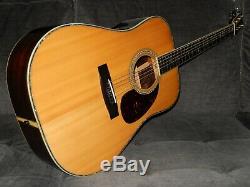
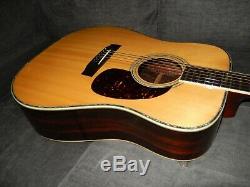
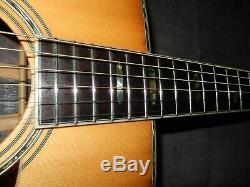

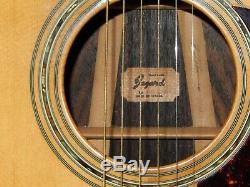
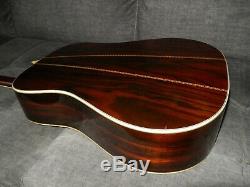

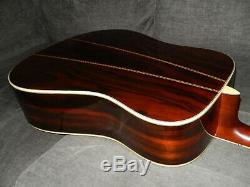
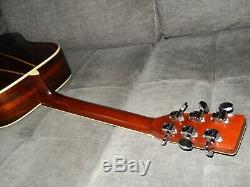
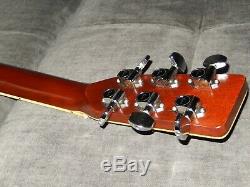

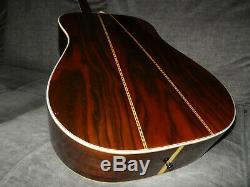


Terada Factory in Nagoya, Japan was founded in 1912 by Mr. Although Terada Factory was making great classical guitars (including El Degas & El Torres) they are best known as one of the highest reputable Japanese acoustic and semi-acoustic guitar makers. They were cooperating with many international importers, making Martin Shenadoah, Sigma by Martin, Orville by Gibson, Epiphone, Ibanez, Gretsch and Fender guitars, just to name a few.
Naturally Terada was also making many guitars for Japanese domestic market, many as OEM especially for Morris Co. In early/mid 1970s and some under their own brand names: Jagard and Thumb. Guitar you are looking at, was made in 1974. Its construction is based on Martin blueprints, but I wont call it a copy. Its volume, response and tonality are far superior to many modern era Martin guitars I have played. It is truly terrific instrument that will surprise many Martin worshipers. Besides bell-like volume, its tonality is very rich and sparkly.With its current (ultra-low) action it plays super easy. This guitar being priced 40 000yen in 1974, was worth about 60% of starting yearly salary of Japanese college graduate (70 000yen at that time).
Even though its body bears very few very minor marks and the finish on its headstock is somewhat cloudy. Overall condition of this guitar can be described as very good for its age. The mostly noticeable imperfection is that plastic bindings/strips shrunk a bit in some places. If you ran you finger along the sides of the fingerboard, you will feel the edges of the neck where they meet binding. This absolutely doesnt affect playability of this guitar.You can also feel edges of center strip at the bottom of the guitar (where the end pin is mounted). In this area the finish cracked on both sides of that center strip. However, the strip itself and side plates are not separated or loose and there is no need for any repairs. Things like that happen on many vintage guitars, including those made in USA, Europe and everywhere else. Top: Solid Spruce/Martin style X bracing with not scalloped braces /gloss finish.
3 piece Back& Sides: "semi-solid" Brazilian Rosewood/gloss finish. Laminated is quite unfortunate term regarding Japanese made guitars. These plates were made from 2 layers of solid wood glued together with natural resins. They were made so well that they performed as good as solid woods while being far less expensive in guitar production and far more resistant to cracking in regular use. In recent years many guitar makers around the world adopted a new term "semi-solid" to describe these plates.
Neck: Mahogany with 2-way truss rod. The action is set to 2.30 mm under E6 and 1.8 mm under E1, with still some extra room on the saddle. Real Value of Japanese Vintage Guitars. The key to understand value of vintage Japanese guitars is to acknowledge galloping devaluation of Japanese yen in 1960s & 1970s. This devaluation was somewhat slower in 1980s.
The best measure of this devaluation is Starting Yearly Salary of Japanese College Graduate (SYSJCG). SYSJCG in 1965 was 19 600 yen, in 1969 34 600 yen, in 1970 39 200 yen, in 1972 62 300 yen, in 1975 79 200 yen, in 1977 86 200 and in 1980 - 100 000 yen. During 1960s and most of 1970s model numbers of Japanese guitars were strictly interconnected with their prices in Japanese yen. In late 1970s and during following decades model numbers were no longer strictly associated with their prices. Many Japanese guitar makers introduced model names instead of model numbers.
Others were still using model numbers with addition of letter abbreviations or other symbols. The best and only logical approach while evaluating real value (real grade) of vintage Japanese guitar is to compare its price in Japanese yen with SYSJCG during the year guitar was made.
Any guitar priced 100 000 in 1970 (labelled usually as No10) would be priced 200 000 yen in 1975 (relabeled to No20 or 2000), 300 000 yen in 1977 (labelled as No3, No30 or 3000). Starting in 1977 Masaru Kohno introduced his new models No40 priced 400 000 yen and No50 priced 500 000 yen. By 1984 Kohno started using model names instead numbers and was raising their prices as he was pleased. Model 50 became model Maestro, model 40 became model Special, model 30 became model Professional-J. Naturally other Master luthiers were doing the same name/price changes. Knowing all of that, you can bet on that Masaru Kohno No50 made in 1982 is practically the same grade instrument as Kohno No20 made in 1972, or Kohno no 30 made in 1976. Kohno No40 made in 1982 is exactly the same grade instruments as Kohno No15 made in 1972 or Kohno No20 made in 1975. All you need to do is. Notify me within 48 hours after receiving the guitar. Pack guitar the same way I do it, using the same box and materials and s. Hip it back to me within 24 hours after "return notification".The item "MADE IN 1974 BY TERADA GAKKI JAGARD JD400 TERRIFIC D45 STYLE ACOUSTIC GUITAR" is in sale since Sunday, November 24, 2019. This item is in the category "Musical Instruments & Gear\Guitars & Basses\Acoustic Guitars". The seller is "victork1962" and is located in Alpharetta, Georgia. This item can be shipped worldwide.
- Exact Year: 1977
- String Configuration: 6 String
- Model: D400
- Country/Region of Manufacture: Japan
- Brand: Kasuga

